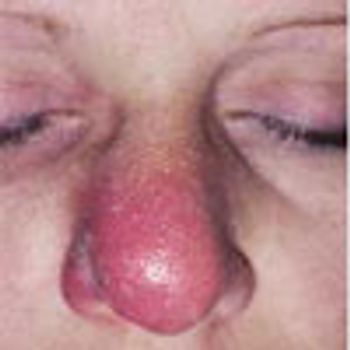
The nasal cellulitis that affects this 39-year-old woman began as right intranasal folliculitis. Because the patient was sensitive to many antibiotics, oral ciprofloxacin was prescribed.
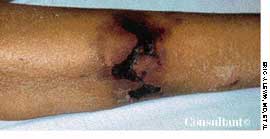

The nasal cellulitis that affects this 39-year-old woman began as right intranasal folliculitis. Because the patient was sensitive to many antibiotics, oral ciprofloxacin was prescribed.
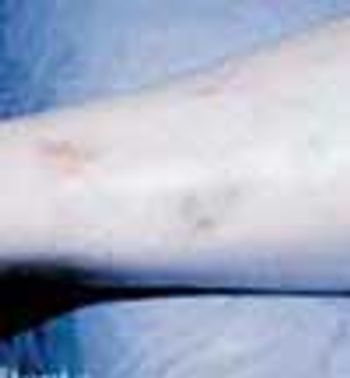
This is a multisystem disorder characterized by oral and genital aphthae. Other symptoms include a myriad of cutaneous findings; variable systemic features include uveitis, synovitis, meningoencephalitis, and large- and smaller-vessel vascular disease.
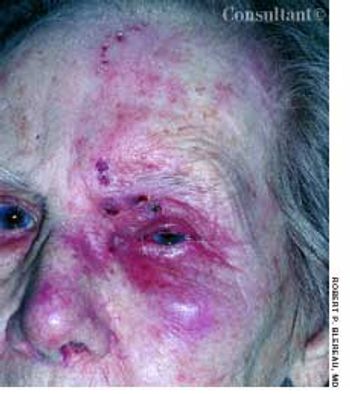
Periorbital, forehead, and nasal erythema, crusting, and pain typical of herpes zoster affected a 90-year-old woman. Reactivation of the latent varicella zoster is more common in the elderly and is attributed to impaired immunologic mechanisms.
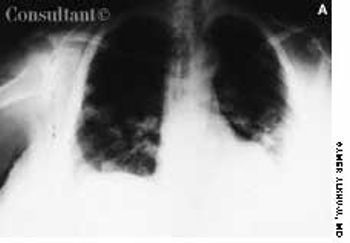
A 49-year-old woman, severely obese but otherwise healthy, appeared for a preemployment medical examination. She neither smoked cigarettes nor drank alcohol. She had no respiratory problems and recalled no family history of such. A baseline mammogram taken 4 years earlier showed no abnormalities, and the patient was not under care for any medical condition. Results of physical examination were normal, except for the obesity-which made it difficult to determine breast masses with confidence.
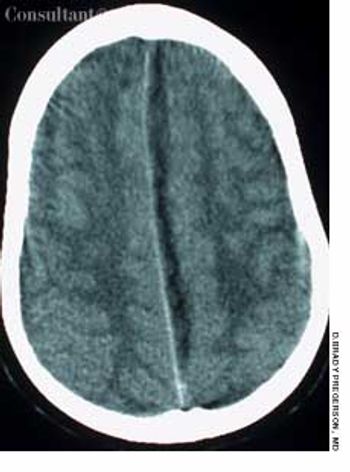
For 7 days, a 10-year-old boy had had a headache and a fever (temperature, 38.8°C [102°F]); a viral upper respiratory tract infection had been diagnosed. His parents brought him to the emergency department when weakness in his right leg developed, which impaired walking.
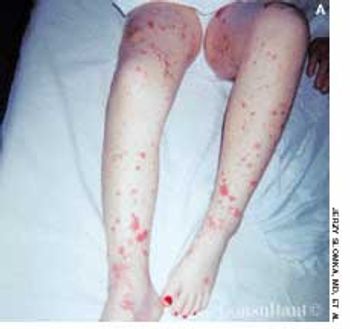
A 6-year-old girl was evaluated in the emergency department for a leg rash that had spread to the buttocks. The lesions first appeared earlier in the day and worsened hourly. The child's mother reported that her daughter was in good health until a low-grade fever, nonproductive cough, sore throat, and headache developed 5 days earlier. The youngster also complained of neck pain with movement.
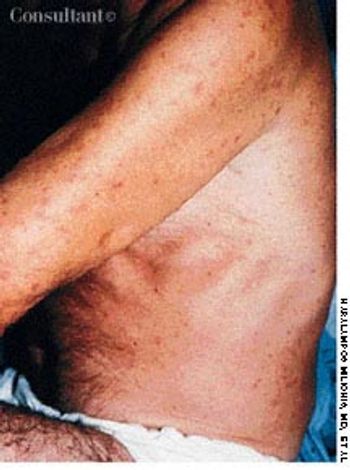
A 49-year-old farmer was hospitalized because of a 3-week history of intermittent fever, fatigue, anorexia, generalized myalgias, and malodorous sweating. A nonpruritic, nonhemorrhagic, maculopapular rash recently had developed on his arms, legs, and trunk. The reddish lesions were less than 1 cm in diameter. There was no history of antibiotic or antipyretic drug therapy, and no abnormalities were found on physical examination.
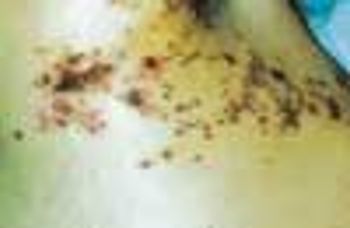
Ten days before presenting for evaluation, a 69-year-old man began to experience neuralgic pain and noticed the eruption of painful erythematous macules and papules on the right side of his chest. Within 24 to 72 hours, vesicles and pustules arose at the site. One week after onset, several of the lesions dried and crusted.
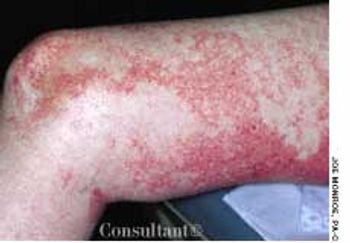
A 44-year-old woman had a painful, burning rash for 4 months. The erythematous eruption was evident on the thighs, fingers, buttocks, abdomen, and perineal and intergluteal areas. Application of triamcinolone cream and emollients offered no relief.
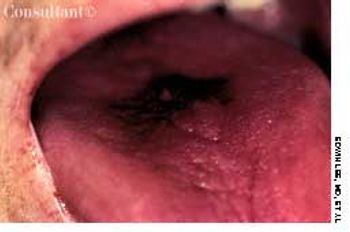
A 35-year-old HIV-positive man had a thick, black, otherwise asymptomatic patch on the top of his tongue. He did not have diabetes.
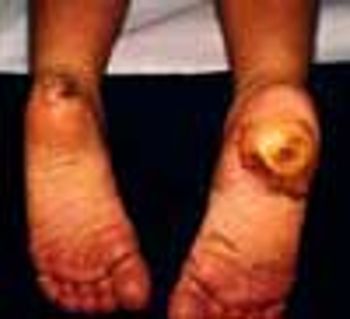
A 6-year-old girl presented with a huge ulcer on her right heel, seen here, that began as a minor laceration when she stepped on a rock several months earlier. On the left heel, there was a similar lesion in the process of healing that had also followed a minor injury. Her feet and hands were dry and hyperkeratotic.
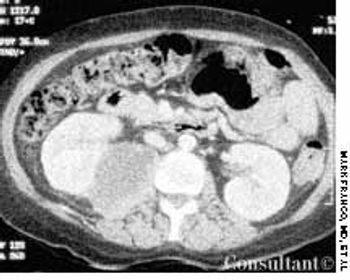
A 49-year-old woman with a history of alcoholic cirrhosis, esophageal varices, coronary artery disease, diabetes mellitus, and hypertension presented to the emergency department with a 2-day history of fever, chills, nausea, and back and abdominal pain. The pain began on the right side, progressed to the lower back, and radiated into the right anterior thigh and groin area.
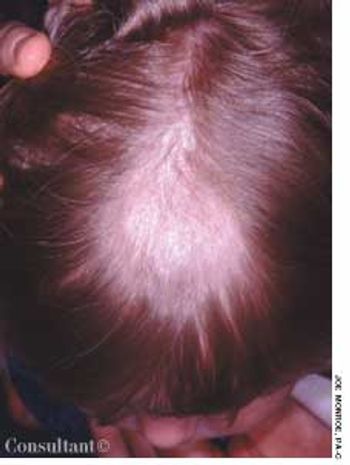
The parents of a 3-year-old girl sought evaluation of their daughter's hair loss. During the past several months, a large patch of alopecia with scaling had developed. The differential diagnosis included seborrhea, trichotillomania, and tinea capitis.
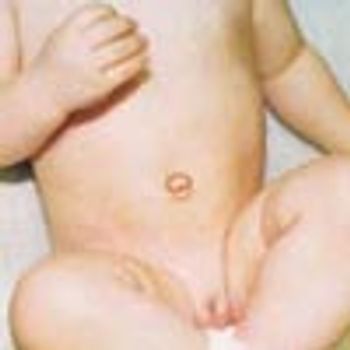
A 3-month-old female infant presented with a mass in the umbilical area. During the neonatal period, an infection of the umbilical cord had resulted in the formation of exuberant granulation tissue at the base of the umbilicus.
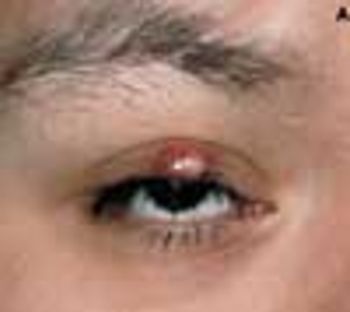
A 23-year-old woman presented with a painful, draining lesion on her right upper eyelid. The draining had begun several days earlier; tenderness and swelling had been present for at least 2 weeks. The patient denied having had similar eyelid lesions in the past.

A 35-year-old dental assistant sought treatment of an itchy, painful rash on her hand that had erupted 5 days earlier.
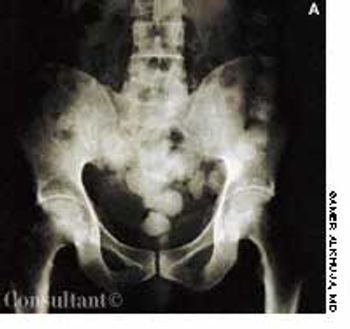
A 52-year-old man from Bangladesh had suffered from pleuritic pain for 1 week. He had never had tuberculosis and-except for being a cigarette smoker-had no notable medical history. The only remarkable findings were a temperature of 37.5°C (99.5°F) and anterior tenderness over the right lower rib cage. Laboratory test results were normal. A tuberculin test with 5 TU of purified protein derivative produced positive results, with a 15 × 17-mm induration.
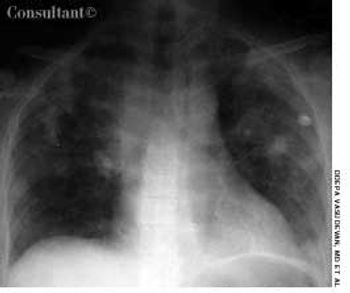
A 37-year-old woman presented with progressive dyspnea of 2 weeks' duration, a low-grade fever, and night sweats. She had been a healthy marathon runner until her exercise tolerance recently declined.

The onset of atopic dermatitis can be seen in infants who have a family history of inhalant allergies, (eg, seasonal allergy, allergic rhinitis, or allergy-induced asthma). The cheeks and large flexural folds of affected children are erythematous and scaly. Involved areas of the trunk and extremities may exhibit discrete patches or a generalized rash.

For years, a 39-year-old man had an eruption on his hand, which seemed to be controlled with topical corticosteroids. The patient was a rancher.

The parents of a 12-year-old sought a consultation for the “cyst” that had appeared on their daughter's lower back. The lesion was first noticed 2 months earlier upon the child's return from a trip to Belize.

A 30-year-old anesthesiologist complained of 5 days of pain in the left epitrochlear and axillary regions. A large, tender node was palpable in each site.

Three weeks after undergoing gastric bypass surgery for obesity, a 64-year-old woman presented with fatigue, chills, and abdominal pain of 2 days' duration. She denied shortness of breath, nausea, vomiting, changes in bowel habits, melena, and hematochezia. The patient had no significant past medical history.

A 16-year-old boy was evaluated for elephantiasis in a remote village in the mountains of Kenya. He complained of drainage from his left leg and reported that for the past several months, after the limb swelled, fluid began to weep from the bottom of the foot. He denied pain in his leg or foot and reported no fever, chills, or sweats.

A 62-year-old woman presented with an itchy, annular eruption on her face of 3 months' duration. A topical antifungal was prescribed, but the slow response to therapy prompted a switch to a topical corticosteroid (triamcinolone 0.1%). The lesion not only failed to clear but became larger.